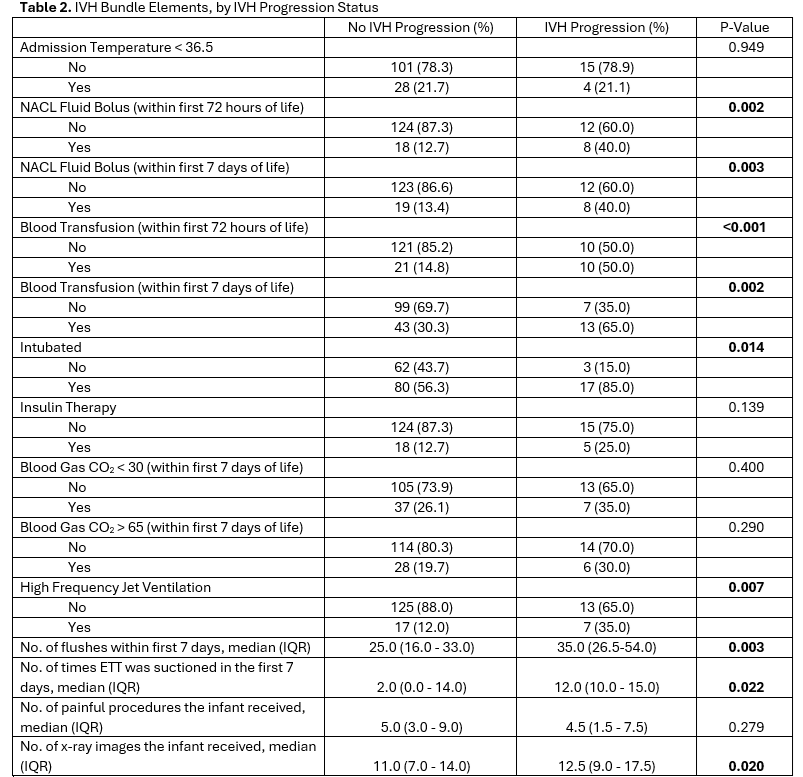Neonatal Neurology 1
Session: Neonatal Neurology 1
332 - Incidence rate and clinical variables affecting the progression of intraventricular hemorrhage grade in premature neonates after the first week of life: a retrospective review study
Friday, April 25, 2025
5:30pm - 7:45pm HST
Publication Number: 332.5328
Jasmeka McCord, Emory University School of Medicine, Sunrise, FL, United States; Vivian Doyle, University of North Carolina, Chapel Hill, NC, United States; Claire Barrette, Joe DiMaggio Children's Hospital at Memorial Regional Hospital, Hollywood, FL, United States; sharell bindom, Joe DiMaggio Children's Hospital at Memorial Regional Hospital, Miramar, FL, United States; Gianina Davila-Zasloff, Memorial Healthcare System/Pedaitrix Medical Group, Davie, FL, United States; Shenae Samuels, Memorial Healthcare System, Hollywood, FL, United States; Monica Arroyo, Joe DiMaggio Children's Hospital at Memorial Regional Hospital, Hollywood, FL, United States

Jasmeka McCord, MD
Fellow Physician
Emory University School of Medicine
Sunrise, Florida, United States
Presenting Author(s)
Background: Despite advances in technology, intraventricular hemorrhage (IVH) continues to affect an estimated 20% of preterm births. Few studies examine risk factors for IVH progression after the first week of life.
Objective: To evaluate the incidence of IVH progression after the first week and associated risk factors in neonates younger than 31 weeks who were included in a study of IVH incidence and clinical variables before and after the implementation of a neuroprotection bundle at our institution.
Design/Methods: Institutional Review Board approval was obtained (MHS.2019.038). Patient records were reviewed, and analyses were conducted using Stata/SE 15.1. Statistical significance was set at P < 0.05.
Results: Records of 366 patients were included with 56% (n=204) in the pre-bundle period and 44% (n=162) in the post-bundle period. There were no statistically significant differences in the overall incidence of IVH between pre and post bundle in the first week, as well as in IVH progression rates between pre and post bundle periods beyond the first week (n=26, 12.9% vs n=20,12.3%; P =0.881). Patients with IVH in the pre and post bundle periods were analyzed together to reach statistical power. IVH progression was defined by worsening grade, changing from unilateral to bilateral or worsening burden of blood products. On average, neonates with IVH progression had a significantly lower gestational age in days (185.3 vs. 191.1; P = 0.026) and a lower weight in kg (0.9 vs. 1.0; P = 0.029) (table 1). Neonates with IVH progression were more likely to develop spontaneous intestinal perforation (SIP) within the first 7 days of life compared to neonates without (20.0% vs. 4.9%; P = 0.012) (table 1). Treatment variable analysis showed those with IVH progression were significantly more likely to have fluid bolus within the first 72 hours and 7 days of life and more likely to have blood transfusion within the first 72 hours and 7 days of life (table 2). Further, neonates with IVH progression were also significantly more likely to be intubated at birth (85.0% vs. 56.3%; P = 0.015) (table 2).
Conclusion(s): During the study period, IVH progression was seen in approximately 12% of all neonates. Neonates with IVH progression were significantly more likely to have SIP within the first 7 days of life, were of lower gestational age and lower birth weight, receive fluid boluses and blood products, as well as to require intubation at birth. Further studies in IVH prevention strategies and factors contributing to IVH progression are needed to continue to define best practices to protect this vulnerable population.
Table 1. Demographics and Clinical Characteristics, by IVH Progression Status
.png) Abbreviations: SD, standard deviation, kg, kilogram; SIP; spontaneous intestinal perforation.
Abbreviations: SD, standard deviation, kg, kilogram; SIP; spontaneous intestinal perforation.Data are presented as mean (SD) for continuous variables, and n (%) for categorical variables.
Proportions represent column percentages. Proportions may not add to 100% due to rounding error or missing/unknown data.
Boldface font denotes statistical significance at P < 0.05.
Table 2. IVH Bundle Elements, by IVH Progression Status
 Abbreviations: NACL, sodium chloride; CO2, carbon dioxide; ETT, endotracheal tube; No., number; IQR, interquartile range.
Abbreviations: NACL, sodium chloride; CO2, carbon dioxide; ETT, endotracheal tube; No., number; IQR, interquartile range.Data are presented as median (IQR) for continuous variables, and n (%) for categorical variables.
Proportions represent column percentages. Proportions may not add to 100% due to rounding error or missing/unknown data.
Boldface font denotes statistical significance at P < 0.05.

